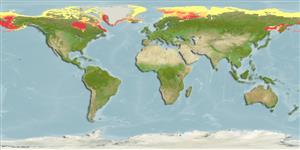Classification / Names
Common names from other countries
Main reference
Size / Weight / Age
Max length : 40.0 cm TL male/unsexed; (Ref. 1371); common length : 25.0 cm TL male/unsexed; (Ref. 1371); max. reported age: 7 years (Ref. 1371)
Environment
Marine; brackish; demersal; oceanodromous (Ref. 51243); depth range 0 - 400 m (Ref. 1371)
Climate / Range
Polar; -2°C - 8°C (Ref. 96379), preferred -1°C (Ref. 107945); 87°N - 52°N, 180°W - 180°E (Ref. 1371)
Distribution
Circumpolar in the Arctic. North Atlantic: White Sea, Iceland, and southern Greenland into the Miramichi River, New Brunswick in Canada. North Pacific: Bering Sea to Cape Olyutorski, the Pribilof Islands, and Bristol Bay.
Countries | FAO areas | Ecosystems | Occurrences | Introductions
Short description
Dorsal
spines
(total): 0;
Dorsal
soft rays
(total): 42-57;
Anal
spines: 0;
Anal
soft rays: 33 - 44;
Vertebrae: 49 - 57. Caudal fin deeply concave. Lower jaw slightly longer than upper jaw. Chin barbel very small. No lateral line pores on head. Scales small and embedded, not overlapping. Brownish along the back with many fine points; the sides and belly silvery; the fins dusky with pale margins (Ref. 1371).
IUCN Red List Status (Ref. 115185)
Threat to humans
Harmless
Human uses
Fisheries: highly commercial
Tools
Special reports
Download XML
Internet sources
Estimates of some properties based on models
Phylogenetic diversity index
PD50 = 1.0000 many relatives (e.g. carps) 0.5 - 2.0 few relatives (e.g. lungfishes)
Trophic Level
3.1 ±0.1 se; Based on diet studies.
Resilience
Medium, minimum population doubling time 1.4 - 4.4 years (K=0.22; tm=2-5; Fec=30,000)
Vulnerability
Moderate to high vulnerability (45 of 100)
Price category
